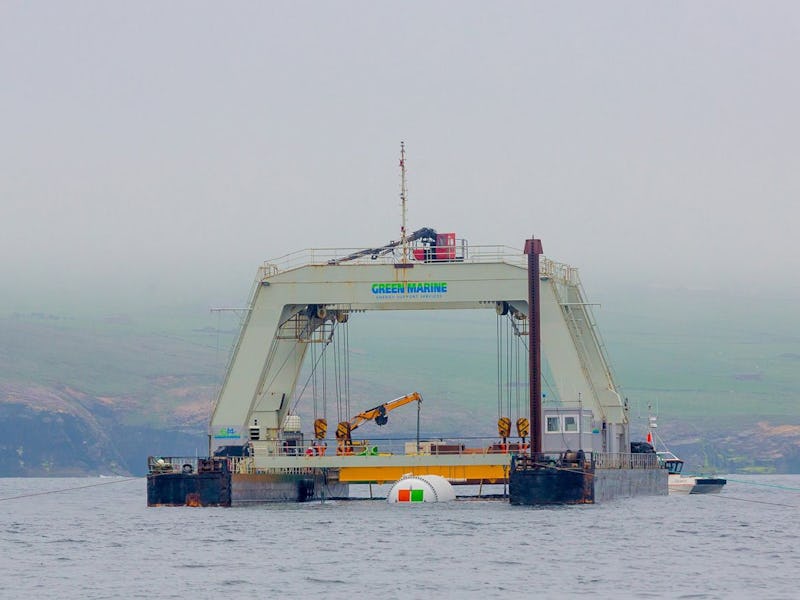Microsoft’s Undersea Data Center Can Survive an EMP Bomb and Space Weather
Saving on cooling costs with these submerged server farms is only part of the story.

Just offshore from the Orkney island archipelago northwest of Scotland, Microsoft’s Project Natick entered Phase 2 this week, lowering an experimental server farm encased in an airtight cylinder into the North Sea. For years now, Bill Gates has been talking to the press about this project and its goal of reducing Microsoft’s energy consumption by letting the oceans cool their servers’ waste heat. But Natick has side benefits: undersea data centers could easily protect critical information and internet architecture from the ravages of solar storms and electromagnetic pulses (EMP), Microsoft’s project lead and two other unaffiliated scientists tell Inverse.
To start, some background. Well-defined environmental considerations permeate nearly every aspect of the project and its eccentric goal of operating data centers underwater off the coast of major population centers. The Orkney site, for example, was selected because the islands are home to a major renewable energy research facility, the European Marine Energy Centre, which focuses on converting waves and tidal flows into electricity.
“We’ve got so much renewable energy here,” the centre’s managing director Neil Kermode told the BBC. “We’ve produced more than we need since 2012.”
Last year, Microsoft published a suggestive patent for an artificial reef — intended as an extension of Project Natick that would surround future submerged data centers with scaffolding-like hoses and trellises for coral reef ecosystems to grow on, as well as nutrients, and warmth (from the server exhaust).
“The motivation for putting things in the water is not to get far away, it’s actually to get close to customers,” Ben Cutler, the special projects manager for Microsoft who oversees Natrick, told Inverse. “If you look at the distribution of human population on the planet, more than half of us are within 200 kilometers of the ocean.”
In other words, underwater data centers have have a number of advantages energy efficiency-wise. They won’t take up expensive real estate on land that might serve a better purpose than a giant computational warehouse, for one. And the proximity to major metropolitan areas promises low latency on processing speeds.
But virtually undiscussed, at least compared to these upbeat sustainability ambitions, is the fact that a submerged data center would also be pretty conveniently fortified from cataclysmic electromagnetic disturbances — simply by virtue of being a hundred feet underwater. In addition to Cutler, two scientists unaffiliated with Microsoft helped explain how this could work.
Astrophysicists, national security experts, and garden-variety paranoids have all expressed concern that turbulent spikes in electromagnetic radiation, natural or man-made, pose an unpredictable threat to our electrical grid and digital infrastructure. There’s the threat of man made electromagnetic pulse (EMP) bombs: high-altitude nuclear blasts whose force compresses the Earth’s magnetic field, creating a power surge that fries nearby circuits and overwhelms the power lines.
There’s also coronal mass ejections (CMEs) — vast clouds of plasma burped out by the sun — to worry about. In the famous geomagnetic storm of 1989, a CME impact in the northern hemisphere blacked out the entire Canadian province of Quebec for 12 hours. The 1859 Carrington Event was another historic CME that lit up skies across the globe bright enough to wake sleeping gold prospectors near the Rocky Mountains.
Project Natick viewed from ashore.
“We do imagine (and I can only say imagine, because we don’t really know) that — given that seawater is this very conductive field and it’s dense — if we have something like that and you’re many meters under the water, you’re probably immune.” Cutler, incidentally a former DARPA project manager, also helps oversee Microsoft’s holoportation research. He says that the only danger to these submerged servers would be from a CME or EMP surge traveling through the data center’s solitary power line to the mainland. But if each data center is successfully tied to a localized sustainable energy source — essentially off the grid — Cutler says he could see these undersea data centers “riding out one of those storms like it didn’t even happen.”
Two other researchers unaffiliated with Microsoft — Egemen Çetinkaya an electrical engineering researcher at the Missouri University of Science and Bill Murtagh, the program coordinator for NOAA’s Space Weather Prediction Center — both agreed with Cutler’s assesment.
“There’s no question that the water affords significant protection from EMP,” Murtagh told Inverse. It would also be relatively inexpensive, he says to add surge protectors to power sources coming in from the mainland “assuming there’s not going to be like hundred of lines going into these data centers.”
Seen alongside the Svalbard Global Seed Vault — a fortified archive of vital plant species in Norway largely funded by the Bill and Melinda Gates foundation — Project Natick sorta looks like another one of Gates’ ambitious doomsday prepping projects. Not in a hermit way, though.